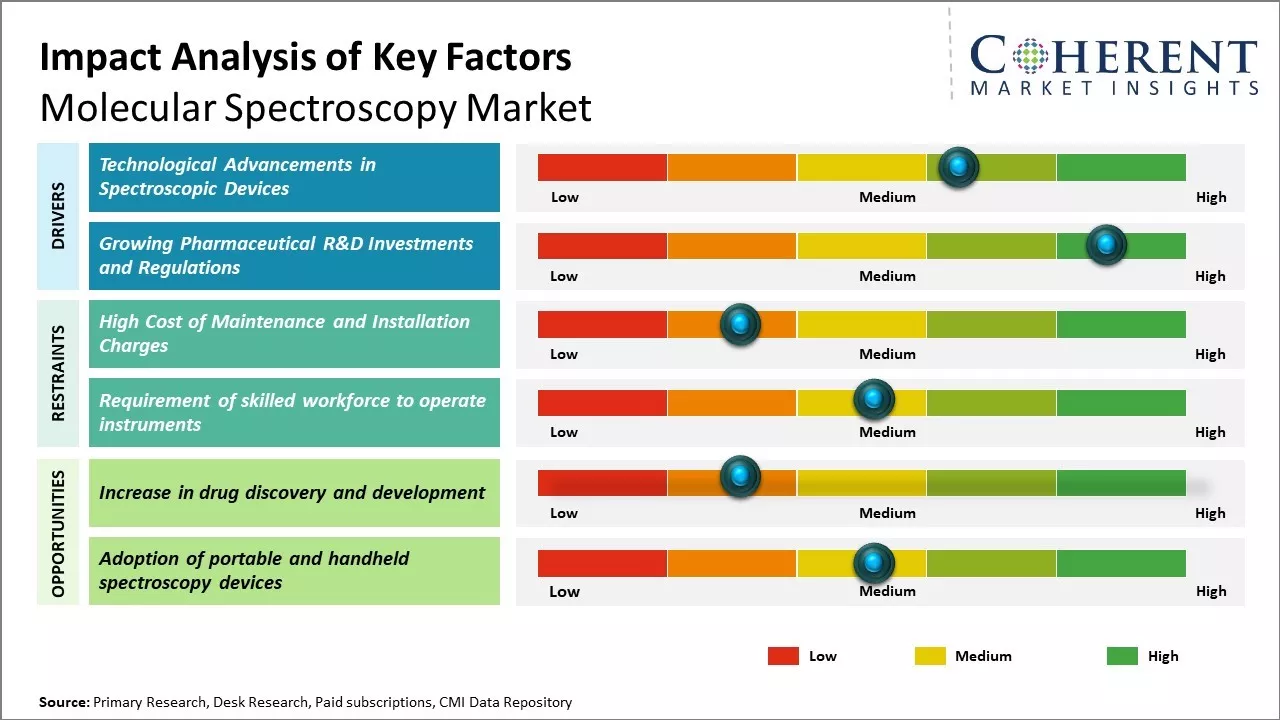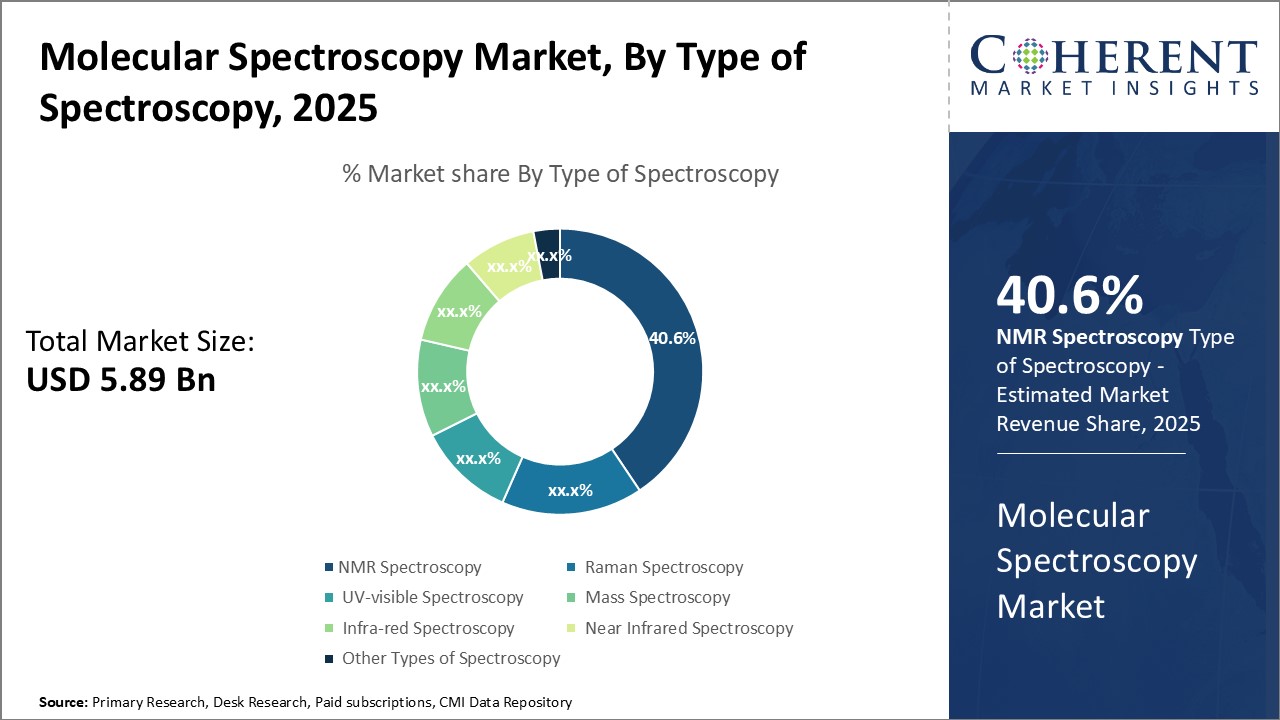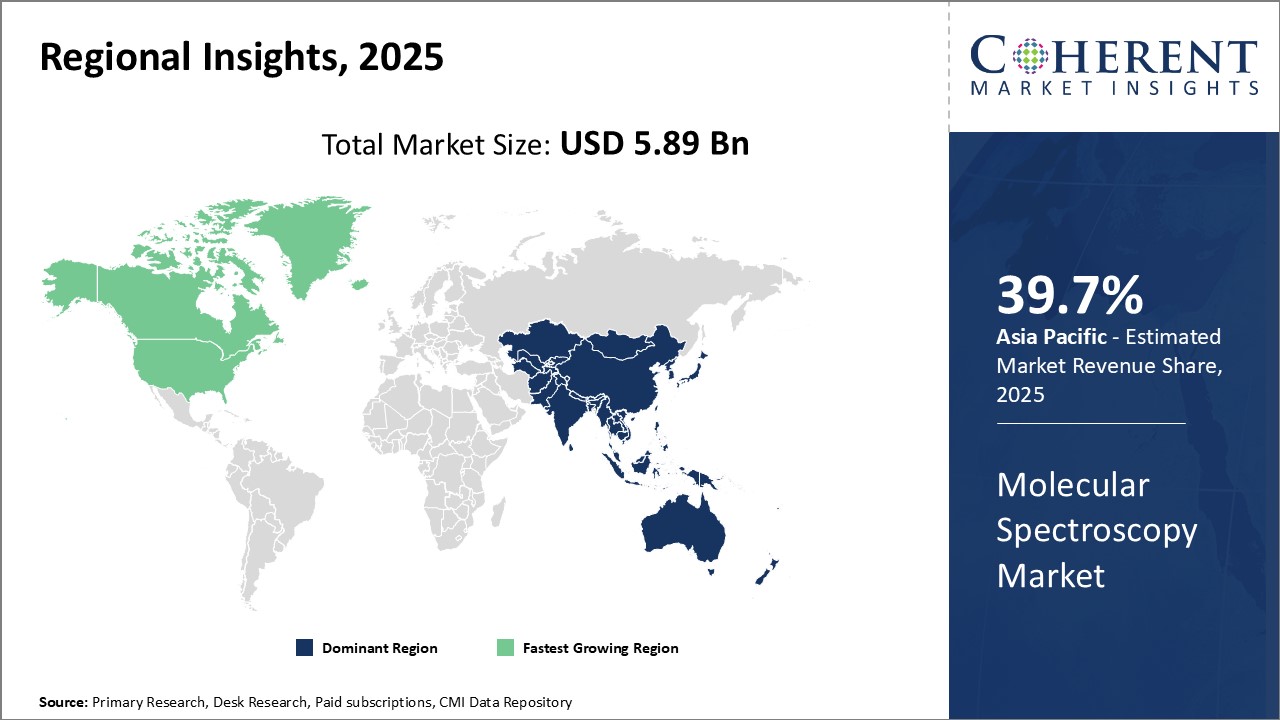The molecular spectroscopy market is estimated to be valued at USD 5.89 billion in 2025 and is expected to reach USD 9.46 billion by 2032, exhibiting a compound annual growth rate (CAGR) of 7.0% from 2025 to 2032.

Discover market dynamics shaping the industry: Download Free Sample
The molecular spectroscopy market is expected to witness significant growth over the forecast period. The market growth is primarily fueled by rising demand for molecular spectroscopy across diverse sectors like pharmaceuticals, biotechnology, chemicals, food and beverage, environmental testing, and academic research. Molecular spectroscopy provides detailed information about the structure, dynamics, and quantitative or qualitative composition of molecules. Technological advancements in molecular spectroscopy tools in terms of miniaturization, portability, and higher efficiency are further expected to boost market revenues. The adoption of molecular spectroscopy for applications including drug discovery, disease diagnosis, organic material analysis and, pollutant monitoring will boost market revenues during the forecast period. For instance, in March 2025, in a publication in Nature, scientific journal researchers from the Max Born Institute in Berlin, Germany, and the Max-Planck Institute of Quantum Optics in Garching, presented a groundbreaking technique for analyzing the properties of matter using light. This innovative approach allows for the simultaneous detection and precise quantification of multiple substances with high chemical selectivity. Operating in the ultraviolet spectral region at extremely low light levels, the method utilizes two optical frequency combs and a photon counter. These experiments offer promising avenues for conducting dual-comb spectroscopy in low-light conditions, paving the way for novel applications in photon-level diagnostics. Potential applications include precision spectroscopy of individual atoms or molecules for fundamental physics tests, as well as studying ultraviolet photochemistry in the Earth's atmosphere or from space telescopes.
Technological Advancements in Spectroscopic Devices
Technological innovations over the past decade have significantly enhanced the capabilities of spectroscopic devices used for molecular analysis. Advanced integrated systems now offer higher resolution, sensitivity and spectral ranges compared to earlier generation instruments. Miniaturized lab-on-chip technologies have enabled portability and enabled molecular analysis to be conducted virtually anywhere. These improvements have expanded use cases for spectroscopy across various industries. For example, handheld Raman spectrometers are now used for rapid detection of contaminants in food processing plants by major agriculture companies. Miniaturized Fourier transform infrared spectroscopy devices integrated with AI have potential applications in pollution monitoring and asthma diagnosis as per recent research publications. For Instance, in March 2022, PerkinElmer introduced a cutting-edge FT-IR liquid food testing platform comprising instruments, software, and optimized workflows. The LactoScope 300 system is adept at identifying crucial indicators like fat, protein, and lactose levels in milk, cream, and whey. Additionally, it can spot adulterants such as ammonium sulfate, maltodextrine, urea, water, and sucrose in both raw and processed milk.

Get actionable strategies to beat competition: Download Free Sample
Growing Pharmaceutical R&D Investments and Regulations
The pharmaceutical industry is among the major end users of molecular spectroscopy techniques for new drug discovery and development. With rising healthcare expenditures, an aging global population and increasing prevalence of chronic diseases, pharmaceutical R&D investments have grown substantially over the past decade. According to reports, over 150 billion dollars are spent annually on pharmaceutical R&D globally. A significant portion of these funds goes towards analytical characterization and testing of drug molecules, metabolites and formulations at various stages - from early discovery to commercial manufacturing. Moreover, regulatory standards by authorities like FDA and EMA have also become more stringent over the years. For instance, in October 2020, Bruker Corporation unveiled the Fourier 80 system in Europe, a benchtop spectrometer utilizing nuclear magnetic resonance (FT-NMR) technology. Additionally, numerous advancements are anticipated to drive notable market expansion throughout the projected period.
Key Takeaways of Analyst:
The molecular spectroscopy market is expected to witness steady growth in the coming years. The market is driven by the rising application of molecular spectroscopy techniques in pharmaceutical and biotechnology research. Areas such as drug discovery, development of new medicines and quality control tests extensively use technologies such as NMR, IR, and MS which is bolstering demand. Additionally, increasing food safety concerns have prompted regulatory authorities worldwide to mandate molecular spectroscopy methods for food quality evaluation.
North America currently dominates the global market owing to substantial investments in pharmaceutical R&D and a strong presence of global market leaders. However, Asia Pacific is poised to be the fastest growing regional market due to rising pharmaceutical production and growing focus on food safety in countries like China, India, and Japan. Nonetheless, high capital requirement for molecular spectroscopy equipment could hamper market growth to an extent. Also, shortage of skilled professionals for operating complex molecular spectroscopy instruments poses a challenge.
Continuous technological advancements leading to the development of high throughput spectroscopic techniques with enhanced sensitivity presents key growth opportunities. Market leaders are focusing on introducing affordable systems with miniature sizes to target research laboratories with limited budgets. Increasing industry-academia collaborations for the development of application specific molecular spectroscopy solutions will further aid the market expansion over the coming decade.
Market Challenges: High Cost of Maintenance and Installation Charges
One of the key challenges the molecular spectroscopy market faces is the high cost of spectroscopic equipment. The instruments can be quite expensive to purchase and maintain. Additionally, skilled professionals are needed to operate these systems and interpret the complex data they generate. Finding and retaining talented spectroscopists poses a hurdle. Another challenge is educating potential customers on the benefits of these techniques. While spectroscopy provides valuable molecular level information, some labs may not see it as a priority for their research or quality control needs.
Market Opportunities: Increase in drug discovery and development
The rise in global research and development activities presents substantial growth prospects in the molecular spectroscopy market, notably boosted during the pandemic. Bruker's launch of PhenoRisk PACS RuO, an NMR test for 'Long COVID' research, underscores this trend. Additionally, the surge in drug discovery and development fuels market expansion, with Raman spectroscopy emerging as a crucial analytical tool. Xtalpi's substantial funding in September 2020 highlights the industry's focus on enhancing digital drug discovery platforms for efficient candidate prediction and development.

Discover high revenue pocket segments and roadmap to it: Download Free Sample
Insights, By Type of Spectroscopy: NMR Spectroscopy contributes the highest share of the market owing to its diverse applications
Nuclear magnetic resonance (NMR) spectroscopy stands out as a vital analytical technique in chemical and biochemical research, with high market share of 40.6% leveraging the magnetic properties of atomic nuclei like 1H and 13C. Its versatility drives its widespread use across various fields: pharmaceutical R&D benefits from structure determination and drug interaction studies; materials science relies on it for polymer and composite characterization; and the food industry utilizes it for component analysis and product authentication. Ongoing technological advancements, including high-field magnets, multidimensional experiments, cryoprobe techniques, and automation, continually enhance NMR's sensitivity, resolution, and throughput, ensuring it remains a cornerstone in molecular structure analysis.
Insights, By Application: Pharmaceutical research drives strong demand for molecular spectroscopy technologies
The pharmaceutical sector drives the demand for molecular spectroscopy, utilizing techniques like IR, Raman, NMR, and mass spectrometry across various stages of drug discovery and development with market share of 35.9%. Spectroscopy enables the precise analysis of molecular structures and dynamics crucial for understanding drug candidates and meeting regulatory standards. As biologics and personalized medicines gain prominence, advanced capabilities like 2D NMR are increasingly vital. To meet evolving needs, vendors focus on improving performance for complex samples and offer tailored platforms and informatics solutions. This ensures spectroscopy remains indispensable for pharmaceutical R&D and manufacturing.

Need a Different Region or Segment? Download Free Sample
North America dominates the molecular spectroscopy market due to the presence of leading life science and pharmaceutical companies, advanced research capabilities, and high healthcare expenditure. The region's sophisticated customer base drives the demand for the latest spectroscopic techniques in various applications. In contrast, the Asia Pacific region is experiencing rapid growth, fueled by expanding investments in life science infrastructure and increasing healthcare accessibility driven by rising disposable income. Local manufacturers in the region are focusing on R&D and quality certifications, driving the adoption of molecular spectroscopy for advanced applications. International brands are also expanding manufacturing or partnership facilities in the Asia Pacific region to capitalize on its attractive growth prospects.
Molecular Spectroscopy Market Report Coverage
| Report Coverage | Details | ||
|---|---|---|---|
| Base Year: | 2024 | Market Size in 2025: | USD 5.89 Bn |
| Historical Data for: | 2020 To 2024 | Forecast Period: | 2025 To 2032 |
| Forecast Period 2025 to 2032 CAGR: | 7.0% | 2032 Value Projection: | USD 9.46 Bn |
| Geographies covered: |
|
||
| Segments covered: |
|
||
| Companies covered: |
Agilent Technologies Inc., Bruker Corporation, Danaher Corporation, Jeol Ltd, Horiba Ltd, Shimadzu Corporation, Thermo Fischer Scientific Inc., Merck KGaA, PerkinElmer Inc., VIAVI Solutions Inc., Thorlabs Inc., Bio-Rad Laboratories Inc., Waters Corporation, Keit Ltd, Renishaw, JEOL, Hitachi High-Tech Science, Nikon, Olympus, Andor, Hamamatsu Photonics, Keyence, Lasertec, and Prometec |
||
| Growth Drivers: |
|
||
| Restraints & Challenges: |
|
||
Uncover macros and micros vetted on 75+ parameters: Get instant access to report
*Definition: Molecular spectroscopy is a field of spectroscopy employed to analyze the composition of samples. It finds applications in pharmaceuticals, food and beverage testing, biotechnology, environmental testing, academic research, and others. Instruments in this market utilize various spectra of electromagnetic radiation—microwave, infrared, visible, ultraviolet, or X-ray—to study interactions between molecules and energy. This enables the determination of molecular properties such as structure, conformation, and purity.
Share
Share
About Author
Manisha Vibhute is a consultant with over 5 years of experience in market research and consulting. With a strong understanding of market dynamics, Manisha assists clients in developing effective market access strategies. She helps medical device companies navigate pricing, reimbursement, and regulatory pathways to ensure successful product launches.
Missing comfort of reading report in your local language? Find your preferred language :
Transform your Strategy with Exclusive Trending Reports :
Frequently Asked Questions
Joining thousands of companies around the world committed to making the Excellent Business Solutions.
View All Our Clients